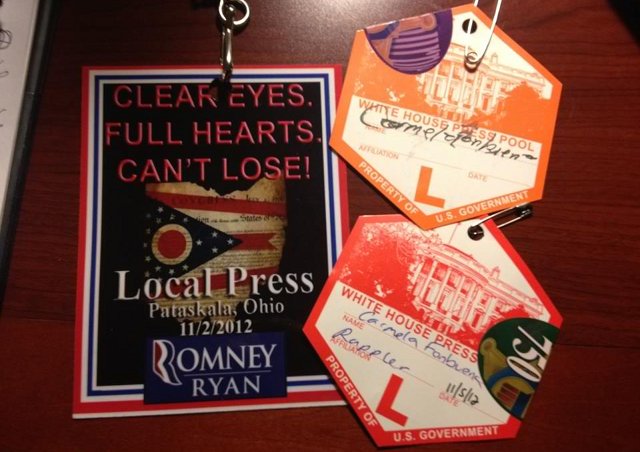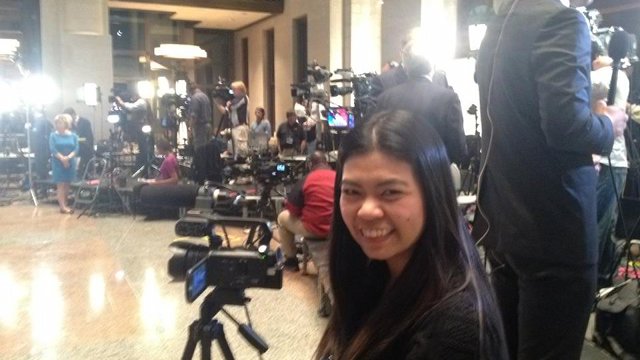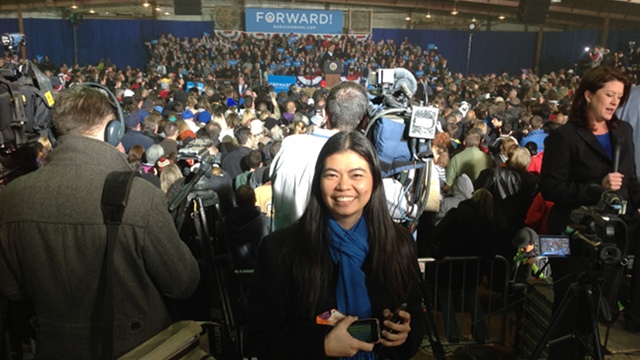SUMMARY
This is AI generated summarization, which may have errors. For context, always refer to the full article.
MANILA, Philippines – Because it was 6 degrees outside, I hesitated. But when the taxi meter reached $48, I decided to walk. I put on my coat and my gloves, grabbed the heavy sling bag carrying my camera and tripod, and walked past long lines of Americans, who – like me – were looking forward to seeing US President Barack Obama that morning of Nov 2, 2012. I was excited!
Freezing outside Ohio’s Franklin County Fairgrounds, a lot of things were going through my head. One, I was afraid the Secret Service wouldn’t let me in. Two, I would need to write a quick script and shoot a video blog. Three, I had to do everything quickly so I could catch Mitt Romney’s campaign event happening in nearby Licking County. And four, I was wondering how expensive that taxi ride would be.
Watching President Obama’s inauguration brought me amazing memories of my coverage of the 2012 US presidential elections. It was a coverage I never imagined I would have the privilege of doing.

For a political reporter like me, it was a dream to watch a powerful country like the US put democracy into practice. And I was in Ohio, the crucial swing that got most of the action. Thank you International Center for Foreign Journalists (ICFJ) for assigning me there, although a part of me really wished for sunny Florida.
Watching the Ohio elections, it was very remarkable how the state bended over backwards to make sure Americans exercise their right to vote. Registration was so easy. Early voting was allowed and the women’s vote actually existed. Regulation of campaign spending and political advertising were also big issues there.
They have very interesting campaign sorties. The Americans don’t just walk in. They have to get their tickets online to be able to attend them. I always secured one for myself in case, you know, the Secret Service wouldn’t recognize my media accreditation.
The difference between the crowds in the Obama and Romney sorties I joined were very stark. Obama’s events were attended by the black, the brown, and the whilte voters. Romney’s was attended by mostly — if not exclusively — white Americans. We reporters were discussing then that the only black man inside the room was a cameraman.
Hearing Obama speak to the Americans, I saw for myself the charm that catapulted him to his historic win in 2008. It’s diminished now, they say, but it remains powerful.
Three days later, on November 5, I would cover another Obama event in a bigger venue in Ohio capital Columbus. It was the same speech he delivered in Franklin County, almost word per word. The free concerts from popular rapper Jay-Z and rocker Bruce Springsteen made it worthwhile.
My coverage of President Obama’s campaign also turned me – a traditional journalist struggling with the new ways of storytelling — into a full-fledged multimedia journalist.
I must belong to the last generation of journalists who romanticize print journalism and the byline. In spite of Maria Ressa’s pep talks, I’ve always tried to wiggle my way out of any assignment that would require me to be in front of the camera. I could do that in the Philippines because there were other reporters who could do it for Rappler. There was no way out of it anymore.
Alone with my gadgets, I turned into a one-woman news factory sending video and text stories while every one back home was sleeping. The time difference was cruel.
In spite of the challenges, I was very ambitious. The experience won’t probably happen again so I made sure to cover as many events as I could. The insanity of the schedule led me to devise a template that Maria said we could use for Rappler’s coverage of the 2013 midterm elections.
I am extremely grateful to the generous people of WCMH NBC4 for going out of their way to help me in my coverage. That taxi ride to Romney I was worried about? The other reporter assigned to cover it waited for me at the station so I could ride with them. Political reporter Ted Hart was the best, letting me tag along and for tirelessly answering my questions on Ohio politics.

I was perhaps a spectacle — me and my little camera, my bestfriend Canon XA10 HD. We joined the big networks – CNN, Fox, NBC and various foreign networks – on the platform rise designated for the television crew. Like clockwork, we all shoot our stand-uppers as soon as the campaign speeches are over. In my head, I’m always laughing at my amused self.
Also, I only learned to operate the little camera a few days before I left for the US. It had been easy to operate it, except that day it decided to make my videos rap with Jay-Z. Among the many lessons I learned from other cameramen there is to bring a steadier tripod. I thought it was smart to carry the thinnest and the lightest tripod, but it shook with the floor everytime a cameraman walked by or when the boom box got too loud.
I was very always very conscious of the many eyes looking at the little camera and at me every time I talk to it – the only unmanned camera in the field. It helped that nobody knew me there. Occasionally, I would look at the group of print reporters typing on their laptops and imagined myself with them.
But there is no going back. I embrace multimedia journalism because this is the future. Journalism is the responsiblity to inform and help educate the public and as it happens, multimedia is the best way to tell stories now.
Contrary to what others may think, it’s not glamorous. It’s a lot of work. But journalism was never meant to be glamorous. – Rappler.com
Add a comment
How does this make you feel?

There are no comments yet. Add your comment to start the conversation.